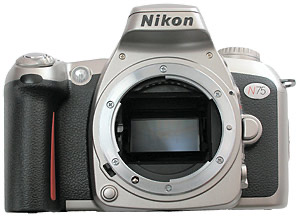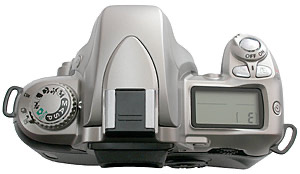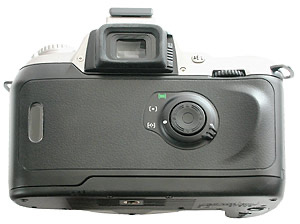This review first appeared on bythom.com and re-edited for this site in 2012.

The N75 body design is simple almost to the point of elegance. There aren't a lot of controls to master, much like the N65. But N65 users will recognize a few differences, most of which are key to improved handling (see the section on Handling, below, for full details).
For example, on the front, the Depth of Field Preview button is now just below the lens mount, not up near the autofocus assist lamp where it cramped hand positions.
On the body top, you'll note that the exposure compensation button has returned to its usual position and we now have a motor drive selector switch centered around the Mode dial.
The back looks quite different, as what is the autofocus selector lock button on most Nikon bodies has transformed into an autofocus mode selection switch. As with most Nikon bodies, put the switches at the "green" positions and the camera is essentially in all-automatic mode.
Still, all in all, very few buttons and knobs, yet they allow you an almost pro-level of control over the camera.
The Basics
A very spooky thing has been happening lately with Nikon product designs: all the things that I have complained about on predecessor models are being quietly fixed. A egotistical paranoid would think that Nikon has been reading the critical part of my reviews and using them as design documents for the next model. A more realistic explanation is simply that Nikon has started recognizing the same problems we users have and has finally taken to eradicating them from their designs. [Just to show you how many of these things there are, I'm going to put a [+] in the text every time we hit one of these fixes of things I'd previously complained about on the N65.]
To wit, the N75 (outside the US, it's called the F75). When it was first announced I thought to myself "we don't need yet another 35mm film body variant" and wondered what the heck Nikon would have done to differentiate it from the N65 and the N80 models that bracket it in price. Well, it's simple. The N75 is differentiated from the N65 by simply fixing all that body's problems, while it's differentiated from the N80 the same way the N65 was: slightly fewer features and a more consumerish (read: automatic) interface. Let's look at the differences between the bodies:
| N65 | N75 | N80 |
| Five autofocus sensors under user control (single button) | Five autofocus sensors under user control (direction pad) | Five autofocus sensors under user control (direction pad) |
| Auto DX ISO coding only | Auto DX ISO coding only | Manual or DX ISO coding |
| Matrix Balanced Fill Flash | Multi-Sensor Matrix Balanced Fill Flash | Multi-Sensor Matrix Balanced Fill Flash |
| Infrared remote control only (optional) | Infrared remote control only (optional) | Standard cable release option only |
| Matrix and Centerweighted metering | Matrix, Centerweighted, and Spot metering (latter two controlled unusually, though) | Matrix, Centerweighted, and Spot metering |
| P, S, A, M plus 6 special exposure modes (some are only way to get certain features) | P, S, A, M plus 6 special exposure modes | P, S, A, and M exposure modes |
| 89% viewfinder coverage | 89% viewfinder coverage | 92% viewfinder coverage |
| +/- 2 EV compensation, 1/2 stops | +/- 3 EV compensation, 1/2 stops | +/-3 EV compensation, 1/2 stops |
| 1/90 flash sync | 1/90 flash sync | 1/125 flash sync |
| No custom settings | 12 custom settings | 18 custom settings |
| 2.5 fps | 1.5 fps | 2.5 fps |
| 30 second to 1/2000 shutter speeds | 30 second to 1/2000 shutter speeds | 30 second to 1/4000 shutter speeds |
| CR2 batteries | CR2 batteries | CR123A batteries |
| Short load time, long rewind time | Long load time, short rewind time | Short load time, long rewind time |
| No grid lines | No grid lines | On demand grid lines |
| 13.9 Oz (395g) | 13.4 Oz (380g) | 18.2 oz (515g) |
All have: Multiple Exposure, Bracketing, CAM900 autofocus sensors, Slow and Rear Sync, and a host of other features. Remarkably, a close set of features across all three bodies, and also remarkably, a reasonably good set of choices from bottom (N65) to top (N80) (the purple cells in the table indicate better features, the pink, worse).

Reading the feature list of the N75, you might wonder if Nikon left anything out. Like the N80, the N75 has nearly every feature even a pro would demand of a camera (with perhaps the exception of build quality).
You get Program, Shutter, Aperture, and Manual exposure modes; diopter adjustments for the viewfinder; a wealth of useful information in the viewfinder (though no frame counter); excellent, though not-quite-state-of-the-art autofocus; 25-segment matrix, and center-weighted (Nikon doesn't specify weighting in the manual, but it is likely 75/25) metering; exposure compensation and three shot auto bracketing; DX auto ISO sensing (but no manual override or display of the set ISO); TTL flash control, including Slow and Rear Sync in regular exposure modes; multiple exposure capability; and depth of field preview.
Put simply, the feature set of the N75 is impressive at its price point. Personally, about the only thing I really miss is the ability to meter with manual focus lenses. But this omission aside, I can't really think of anything I'd want to add to this lightweight, low-cost body.
Handling
The N65 was crippled by one fatal flaw: certain of its features were "embedded in" the special exposure modes. If you wanted continuous motor drive, for example, you had to select Sports exposure mode and settle for the other compromises that all automatic mode made. Well, Nikon's been listening; with perhaps one exception, this flaw is now banished [+], and even the remaining issue can be fixed with a custom setting.

Besides being lighter in weight, the N75 is a bit smaller than the N80. Amazingly, while putting in a few more features and retaining the N65's features, the N75 manages to shave a few tenths of an ounce off the weight (it uses the N55 body form, which is slightly smaller). This is a small, light body. Unfortunately, you may find that the small size and some of control placements makes the camera feel a bit uncomfortable, especially if you have large hands or long fingers. I'm almost certain that Nikon styled this body to fit a smaller, woman's hand. Still, the hand positions aren't quite as constrained as they were with the N65. This is most noticeable with the new location of the depth of field control [+], for instance (it's been moved to just below the lens from a position that used to be too close to the shutter release on the N65). The exposure compensation button is back where we expect it [+] (just behind the shutter release), which helps the hand position, too. So, while this is still a body for smallish hands, at least you don't feel contorted when using common controls.
Gone is the N65's awkward autofocus sensor selection button, and in its place is the direction pad we've come to know and love. [+] It's a real bonus that in place of the direction pad lock button we also now have an autofocus mode selector. Explaining the autofocus options on this camera is so much easier than on other Nikon's simply because of that control (makes you wonder why it hasn't been used on other consumer bodies). The new "green" position (green indicates all-automatic, or idiot-proof, settings on Nikon bodies) locks the direction pad and lets the camera make all the decisions about which sensor to use (Dynamic AF with Closest Subject Priority). The other two positions are Dynamic AF with Center Subject Priority (what used to be called Single Area autofocus with the center sensor selected) and Dynamic AF. If these names look a bit unfamiliar, that's because, yes, we basically have a new set of options, though using the old feature set to "build" them. Rather than have three places where you can select autofocus options, Nikon has simplified things down to this control (and some minor changes that occur with other camera settings; yuck, more embedding!).
But the interesting thing is this: unlike the other Nikon bodies, you probably won't be scrambling to the manual to try and figure out what the camera is doing. Why? Because the default is that you set the selector, press the shutter release, the camera focuses, AND THEN the camera lights up the autofocus sensor being used (and beeps to tell you it has achieved focus if you have sound on, which is the default). Holy mackerel, what a concept! Instead of giving the user lots of cryptic switches that interact and telling the user that the autofocus sensor that gets used might not be the one you selected, here everything is simplified and turned around in such a way that you may actually learn what the settings do from trial and error. While it may still take you a while to master the different autofocus possibilities of this camera, you won't be confused about which sensor is being used. Ever.
A dial on the left top plate is used to set the camera's exposure mode (and the special program modes). This dial is clearly labeled and easy enough to use. Gone are virtually all of the embedded functions in special exposure modes [+], but still remaining are limitations to what you can do in special exposure modes. For example, you generally can't set bracketing, multiple exposure, and sometimes even some flash options or exposure compensation in these modes. While the exposure modes finally seem to set more extreme settings (hey, finally f/2.8 in Portrait mode!), frankly, I could have done without these additional modes--none of them really do anything particularly useful, in my opinion.
Continuous motor drive is now available via a separate frame advance selector instead of being embedded in a special exposure mode [+]. Curiously, Nikon didn't put the multiple exposure mode in this same selector (it's the last option in the bracketing button sequence). This is probably a good choice considering the audience for the camera. To get multiple exposures you're going to have to set it intentionally, not accidentally move the motor drive switch to the wrong position. Likewise, the self-timer is set by a separate button. I think this shows that Nikon has actually thought a little bit more about the user of this camera and tried to make advanced features as logical as possible, but not easy to accidentally set.
Setting apertures still takes a bit of getting used to if you're moving down from one of the fancier bodies: if you're in aperture priority exposure mode, you just rotate the Rear Command dial. If you're in manual exposure mode, however, you must hold down the exposure compensation/aperture button and rotate the Rear Command dial.
Metering is performed via a new 25-matrix design most of the time. When you press the AE-L button (or use Manual exposure mode), the camera automatically switches to center-weighted metering. But...Nikon now provides a custom setting to make the AE-L button perform matrix metering [+], center weight, or spot metering (this is the only way to get to spot metering, by the way). No more seeing an exposure and having it change when you press the exposure lock button! (Assuming you change the custom settings, that is.)
One note about film loading: like the N55, the N75 winds the film to the end of the roll when you first load it and then rewinds it back into the canister as you take pictures. Thus, there is a longish delay between closing the back and being able to take the first picture on a new roll, but only a very brief delay before you can open the back and remove the film. This also has the side benefit of mostly protecting the pictures already taken should you inadvertently open the camera back prior to the last exposure, something amateurs may appreciate.
Overall, I'm pleased with virtually all the changes Nikon made to the N65 to create the N75. The N75 handles pretty much the way I'd like it to, while the N65 often made me stop and think (and consult charts to see which special mode I had to set to get a feature). Indeed, the advance is enough that I'd state this: anyone considering the N65 should get the N75 instead. Period.
Performance
Exposure
The N75 matrix meter is accurate, though note that it uses 1/2 stop increments, which isn't good for slide shooters. That said, I didn't find any exposures in my initial set of slides that I was uncomfortable with. And you can always dial in exposure compensation or turn on the exposure bracketing, if you're really worried.
Manual exposure users should note that you get only two stops of metering information on each side of 0. But also note that you don't get matrix metering in manual exposure mode. Instead, you get an unspecified (in the manual, at least) center-weighted system.
My N75 book goes into the exposure system at great length, but suffice it to say that, like most Nikon SLRs, the N75 is fine at handling 80% or more of the situations you throw at it, and a little knowledge can help you perfect that remaining 20%.
Autofocus
The CAM900 sensor used in the N75 has two primary liabilities: the outlying sensors all have more trouble with low contrast subjects than the central one, and in low light those same sensors are also less sensitive. While the same is true of the N65, N80, and D100, with the N75 it's a little easier to deal with. If normally you have the camera in the "magic autofocus" position (the green setting for Dynamic AF with Closest Subject Priority), just flip it down one setting and you're using only the central sensor.
AF-S lenses focus quite swiftly on an N75, as they do on all other recent Nikon bodies. Indeed, I was a bit surprised at how well the AF-S and VR lenses worked on an N75. The 24-85mm AF-S lens is a perfect companion for this camera (the upcoming 24-120mm VR AF-S is a bit big for the body, in my opinion, but if you want VR to steady shots, it's a valid choice). Note, however, that if you use the VR lenses on the N75 you'll gobble up your batteries much faster, and CR2 batteries aren't as easy to find as AA or even CR123A.
Drawbacks
- Build Quality. Exactly what you'd expect for an inexpensive body; you'll want to take precautions to keep this camera sheltered from the elements. But other than that it seems hardy enough; certainly as good as my N65, which has withstood one heck of a lot of travel as a backup body (i.e., stuffed away in a pack that gets thrown around a lot).
- Flash sync is only 1/90. That, coupled with the weak internal flash don't make for as much flexibility as I'd like. Example: at ISO 100 with an f/2.8 lens on the camera, your maximum shooting range is 14 feet (4.2m). Moreover, the built-in flash can't be used with virtually any zoom that goes wider than 28mm due to its position so close to the prism. The SB-50DX makes a decent complement to the camera and fixes many of the internal flash limitations (the SB-80DX is a better flash, but a bit big for the camera body). But note that the SB-50DX and N75 use different battery types.
- Manual lenses. If you've got AI or AIS lenses, you won't be using them very often on the N75, as the body can't meter with them. That's a shame, as I'd love to take my Series E lenses with this body to save weight on backpacking trips.
- Only one battery in QD versions. The date and time stamp versions of the body use the main camera battery. If the camera is without power for more than 30 minutes you must reset the date and time.
Positives
- The N65 has been fixed. Virtually all of the issues I had with the N65 have been addressed. Bravo Nikon.
- Bang for the buck! I thought the N80 was a good value, but the N75 now easily tops that. If you can live with a few missing features, this body is a tremendous value.
- Feature specification is rich and deep. When a low-cost body even includes diopter correction for the viewfinder and multiple exposure capability, you won't find much missing.
